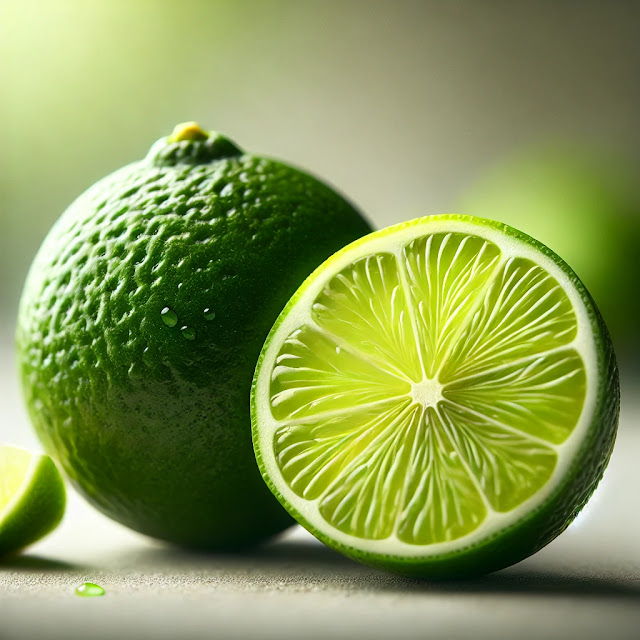Zest for Life: The Health Benefits and Versatility of Limes
Overview:
Limes, with their tangy and refreshing flavor, are a staple in many kitchens around the world. Known for their vibrant green color and strong citrus aroma, limes are a versatile fruit that can enhance both savory and sweet dishes. Whether squeezed over a dish for extra zing or used in beverages, limes add a burst of flavor and a wealth of nutrients to your diet.
Calories and Key Nutrients (per 100g):
Limes are incredibly low in calories, providing just 30 calories per 100g. They are a rich source of Vitamin C, which covers about 32% of the recommended daily intake. Limes also contain small amounts of calcium, iron, potassium, and Vitamin A. In comparison to lemons (29 calories per 100g) and oranges (47 calories per 100g), limes are similar in terms of calories but offer a slightly different nutrient profile, particularly with their higher acidity and tartness.
Health Benefits:
Limes are packed with antioxidants that help protect the body from damage caused by free radicals. The high content of Vitamin C in limes is essential for supporting the immune system, promoting healthy skin, and aiding in the absorption of iron from plant-based foods. Additionally, limes can improve digestion by stimulating the production of digestive enzymes and relieving indigestion or bloating. The natural acidity in limes also helps balance pH levels in the body, which can contribute to better overall health.
Proper Consumption Methods:
Limes can be used in a variety of ways to enhance both food and drinks. A common method is adding lime juice to water for a refreshing, tangy beverage. You can also use lime zest in baking to add a citrusy aroma to cakes or cookies. Limes are perfect for marinades, salad dressings, and even sauces for seafood or poultry. They can also be added to cocktails like mojitos for an extra burst of flavor.
Delicious Ways to Enjoy (Recipe):
One easy and delicious way to enjoy limes is by making a Lime Avocado Salad. Simply mix diced avocado with chopped cilantro, cherry tomatoes, and red onions. Drizzle fresh lime juice over the salad and sprinkle with a bit of sea salt for a light and refreshing dish. Alternatively, create a lime-infused dressing by combining lime juice, olive oil, garlic, and honey—perfect for any summer salad.
Consumption Warnings:
While limes are generally safe to consume, their high acidity can cause tooth enamel erosion if consumed in large amounts. It’s best to drink lime juice diluted with water and avoid frequent direct contact with teeth. Additionally, people with acid reflux or a sensitive stomach should be cautious, as the acidity can aggravate these conditions.
Comparison with Other Fruits:
Compared to other citrus fruits like lemons or grapefruits, limes have a similar calorie count but offer a stronger, more concentrated flavor due to their higher acidity. While lemons are often used to add brightness to dishes, limes bring a slightly bolder tartness, making them ideal for spicier cuisines. Both lemons and limes are rich in Vitamin C, but limes have a higher concentration of citric acid, giving them their sharper taste.
Who Should Eat and Who Should Avoid:
Limes are great for people looking to boost their immune system or improve digestive health. The high Vitamin C content makes limes particularly beneficial for athletes, helping them recover from physical exertion while also promoting hydration. However, people with acidic conditions, such as stomach ulcers, should avoid excessive lime consumption, as the high acidity could exacerbate their symptoms.
Fun Facts:
Did you know that limes were historically used by British sailors to prevent scurvy? The nickname "limey" comes from the sailors' regular consumption of limes to prevent Vitamin C deficiency during long sea voyages. Additionally, limes are one of the most common ingredients in Mexican and Southeast Asian cuisines, where they are used to balance bold flavors in dishes.
Lime in Different Cultures:
In Mexico, limes are often served alongside tacos, grilled meats, and seafood to enhance the flavors with a fresh, tangy kick. In Thailand, limes are used in traditional dishes like tom yum soup and pad Thai, where their acidity helps balance the spiciness and richness of the ingredients. In India, limes are frequently pickled to create a tangy condiment known as nimbu ka achar, which adds flavor to various curries and rice dishes.
Research Findings on Limes:
Recent studies have shown that the flavonoids and limonoids in limes may have anticancer properties, helping inhibit the growth of cancer cells. Additionally, the high level of citric acid found in limes has been linked to improved kidney health, as it helps prevent the formation of kidney stones by increasing urine citrate levels, which reduce stone formation.
Additional Tips:
For a quick detox drink, mix fresh lime juice with warm water and a bit of honey. This drink not only hydrates but also helps stimulate digestion and boosts metabolism. Lime juice can also be used as a natural cleaning agent—its acidity makes it excellent for cutting through grease and removing stains from kitchen surfaces.







.%20The%20whole%20horned%20melon%20should%20be%20bright%20orange%20with%20distinctive.webp)



Comments
Post a Comment